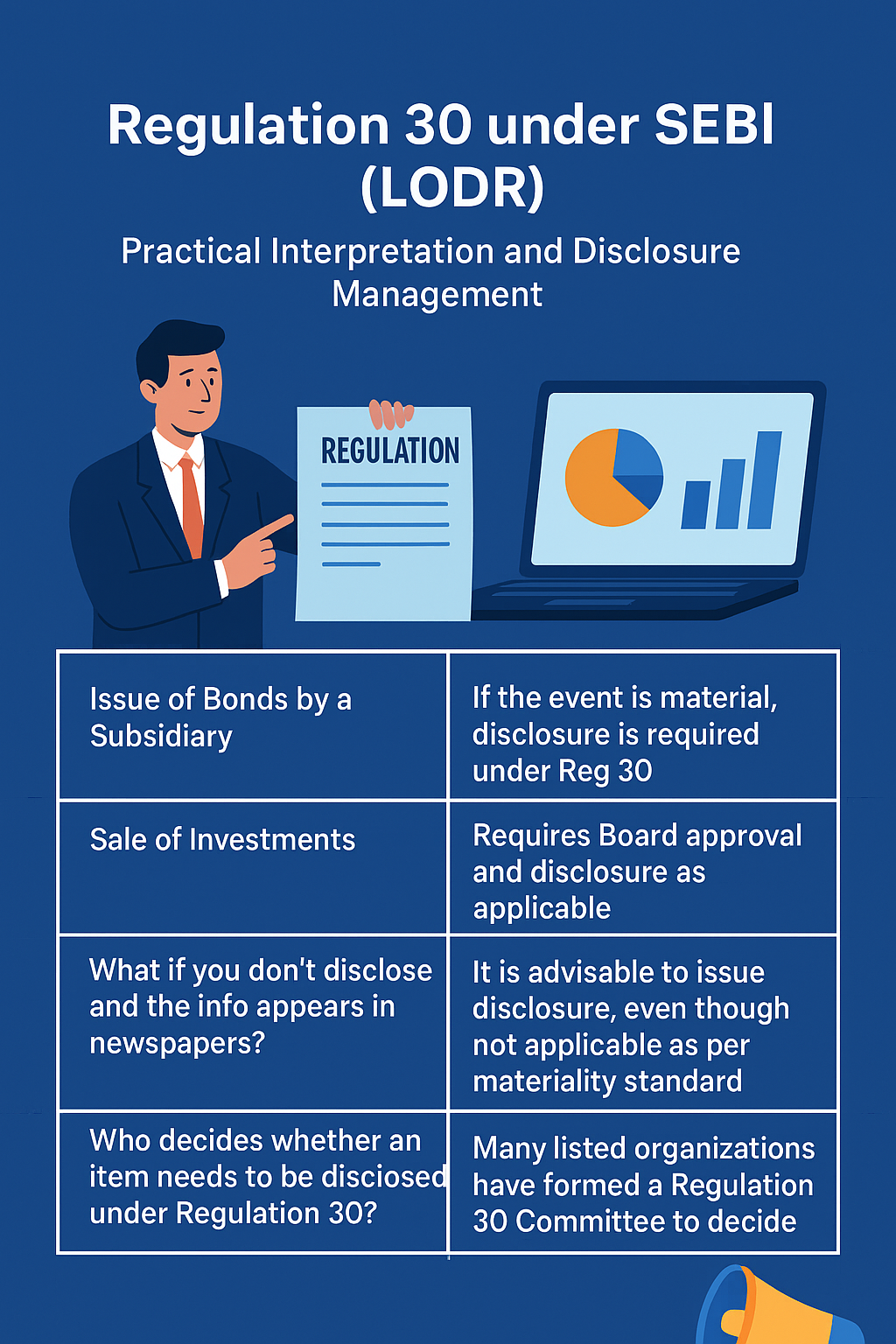View News
Regulation 30 under SEBI (LODR) – Practical Interpretation and Disclosure Management

Regulation 30 under SEBI (LODR) – Practical Interpretation and Disclosure Management
Overview
Regulation 30 of the SEBI (Listing Obligations and Disclosure Requirements) Regulations, 2015 requires listed companies to make timely and accurate disclosure of material events or information. The compliance officer must apply a materiality test, identify the correct stage of disclosure, and ensure timely submission to the stock exchanges.
The following table summarises key interpretational points and best practices for corporate secretaries and compliance teams.
Detailed Guidance Table
| Issue / Question | Interpretation & Principle | Action Points for CS / CO | Stage / Timing for Disclosure | Illustration / Template |
|---|---|---|---|---|
| 1. Issue of Bonds / Securities by Subsidiary | Disclosure required only if the transaction is materialfor the listed holding company. Materiality must be tested quantitatively and qualitatively. | Evaluate materiality; identify the event stage (enabling resolution ? board approval ? execution). If material, prepare disclosure within 30 minutes of the board meeting or once terms are finalised. | At the stage of board approval or definitive documentation. | “A subsidiary of the Company has approved issuance of bonds amounting to USD … for …. Further disclosures will be made as the transaction progresses.” |
| 2. Sale of Investments | Requires board approval (as per SS-1). If material, falls under Para A of Schedule III; if not, under Para B. | Obtain formal board approval (not circular). Check if shareholder approval is required. Prepare stock-exchange disclosure accordingly. | Immediately after board / shareholder approval. | “The Board has approved the sale of [name of investment] for ?… on [date]. The transaction is subject to ….” |
| 3. Non-Disclosure followed by Media Report | If information appears in media before company disclosure, the exchange may seek clarification. | Prefer proactive disclosure even if materiality seems borderline. If news appears, issue clarification quickly to prevent speculation. | On the same day the report appears or when clarification sought by the exchange. | “With reference to recent media coverage, the Company clarifies that … . Further updates will be shared when approved.” |
| 4. Decision-Making Authority under Reg 30 | The responsibility rests with Key Managerial Personnel. Many companies create an internal “Regulation 30 Committee” (MD, CFO, CS). | Form such a committee; maintain minutes for every materiality discussion; record the reasoning for disclosure or non-disclosure. | Immediately after internal committee or board decision. | Maintain written minutes: date, members, issue, reasoning, and final action. |
| 5. Handling Market Rumours | If a rumour materially affects share price or relates directly to the company’s operations, clarification is required. | Monitor share-price movements and media daily; prepare factual clarifications; avoid speculative wording. | As soon as the price movement or rumour is observed. | “In response to speculation regarding …, the Company confirms that … . There are no undisclosed events requiring announcement.” |
| 6. Legal Notices & Defamation-Type Matters | High-value or repetitive legal notices (especially defamation or large-claim matters) may meet materiality thresholds. | Maintain a register of all legal notices; evaluate under PPR test (Probable–Possible–Remote). Disclose if the claim is probable or possible and crosses thresholds. | On receipt of notice or change in status. | “The Company has received a legal notice dated … alleging …. The matter is assessed as [Probable/Possible/Remote] and will be updated accordingly.” |
| 7. Courier / Post Received After Hours | Delay in processing physical documents can cause breach of disclosure timelines. | Implement an internal SOP—reception must scan and email all incoming regulatory letters immediately to the CS team even after office hours. | Immediately upon physical receipt. | “All official correspondence received after 5 p.m. shall be scanned and emailed to the Compliance Officer within 30 minutes.” |
| 8. Tax / Labour / Regulatory Orders in MGT-7 | Orders and notices under Income-tax, GST, PF, ESIC etc. must be reported where relevant in MGT-7 and Board Report. | Maintain register of all notices and penalties (paid/unpaid/under appeal). Include summary in annual filings. | Annually, as on reporting date. | Include a table of pending matters with department, date, and amount. |
| 9. Induction of New Secretarial Team Members | Proper induction avoids compliance lapses. | Provide written SOPs and explain key areas: Reg 30, RPT, Insider Trading, Code of Conduct, and SDD maintenance. | Within first week of joining. | 3-day orientation on LODR + 2-day internal process training. |
| 10. Ongoing Training & Awareness | Regular refreshers ensure preparedness. | Schedule training—monthly internal sessions, quarterly peer-review discussions, yearly audit of disclosures. | Continuous. | Maintain training logs and attendance. |
| 11. Use of AI / Chatbots for Stakeholder Queries | Automated replies must not be used verbatim for regulatory communication. | Review all AI-generated drafts before publication; ensure human vetting by CS. | Prior to external release. | “All automated content shall be verified and approved by the Compliance Officer before disclosure.” |
| 12. Compliance Dashboard | A dashboard tracks disclosure events, owners, and due dates. | Implement real-time dashboard with alerts for 30-minute/24-hour deadlines. | Ongoing. | Columns: Event |
| 13. Scenario Playbook | Helps teams act quickly on recurring situations. | Create pre-approved templates for M&A, market rumours, litigation, default, auditor change, etc. | Referred at time of each event. | Use decision-tree approach for immediate clarity. |
| 14. Foreign Subsidiary Transactions & Hedging | Disclose only material information relevant to holding company; avoid unnecessary tax exposure under DTAA. | Account hedge cost in parent books; disclose factual details if material; coordinate with finance & tax advisors. | Upon approval or completion, if material. | “A subsidiary has arranged external financing of USD … ; the impact on consolidated statements will be disclosed once finalised.” |
| 15. Appointment / Change of Auditors | Disclosure of Statutory and Secretarial Auditor appointments/resignations is mandatory. Cost and Internal Auditors – optional but available in XBRL dropdowns. | File disclosure immediately after board/shareholder approval. | Within 30 minutes of board meeting (if appointed) or promptly on resignation. | “Pursuant to Regulation 30, … has been appointed as Statutory Auditor of the Company for FY … .” |
| 16. Show-Cause Notices & PPR Test | Apply the “Probable–Possible–Remote” framework. Disclose if Probable or Possible. Re-assess at each stage. | Maintain register of all notices with classification and reasons. | Upon receipt or whenever the status changes. | “Company received a notice dated … . Based on legal advice, the matter is considered Possible; further updates will be shared.” |
| 17. Contingent Liabilities (Aggregate Materiality) | If cumulative contingent liabilities exceed the company’s materiality limit, further notices become disclosable irrespective of size. | Maintain a separate running total; update Board and Audit Committee when threshold crossed. | On crossing materiality threshold or year-end review. | “As of …, aggregate contingent liabilities amount to ?… . Further updates will be disclosed as required.” |
Internal Formats
Regulation 30 Committee – Model Minutes
Date: [dd/mm/yyyy] Attendees: MD / CFO / CS Item: [Event description] Materiality: [Yes/No – quantitative & qualitative basis] Decision: [Disclose / Not disclose / Defer] Rationale: [Brief reasoning] Timeline: [Immediate / within 30 mins of Board meeting] Action Owner: [Name]
Regulation 30 – Scenario Matrix
| Scenario | First 30 Minutes | Next 24 Hours | Responsible |
|---|---|---|---|
| Board-approved material event | Prepare & file initial disclosure | Upload detailed information / documents | CS + MD |
| Market rumour affecting share price | File factual clarification | Update if confirmed / Board approval obtained | CS + Legal |
| Show-Cause Notice (Probable/Possible) | Inform Board / Legal Head | File disclosure & track updates | CS + Legal |
| Foreign financing transaction | Draft short factual note | Disclose final impact once executed | CFO + CS |
| Material investment sale | File disclosure after board approval | Follow-up disclosure post-completion | CS |
Compliance Dashboard (suggested columns)
| Event ID | Date Received | Source | Description | Materiality | Owner | Deadline | Status | Remarks |
|---|
Disclosure Templates
(a) Material Event – Board Approval
“Pursuant to Regulation 30 of the SEBI (LODR) Regulations, 2015, the Board of Directors at its meeting held on [date] approved [brief description of event]. Further details will be provided as the transaction progresses.”
(b) Clarification on Rumour / Media Report
“With reference to media reports dated [date], the Company clarifies that [brief factual position]. The Company will update any material developments as required.”
(c) Show-Cause / Legal Matter
“The Company has received a communication dated [date] from [authority]. The matter is being examined and will be disclosed further if it becomes material.”
SOP Highlights
-
Every physical or electronic communication from any regulator must be recorded, scanned, and escalated the same day.
-
Maintain a live “Reg 30 Register” of events, their stages, and filing timestamps.
-
Periodically re-evaluate materiality, especially for cumulative litigation or contingent liabilities.
-
Keep contemporaneous minutes for every internal decision not to disclose — this is your defence in case of later regulatory queries.
-
Prefer factual brevity over narrative explanations in stock-exchange submissions.
Practical Takeaways
-
Apply the materiality test first, disclose later — never skip documentation of reasoning.
-
Monitor external triggers (media, market price, competitor disclosures).
-
Automate alerts through a compliance dashboard.
-
Keep a playbook of templates ready for common scenarios.
-
Train every level of staff — even reception/security — to recognise time-sensitive documents.
-
Do not rely on AI outputs verbatim; always apply human legal review.
-
Disclosure cost is always lower than the cost of non-compliance.
Unlock the Potential of Legal Expertise with LegalMantra.net - Your Trusted Legal Consultancy Partner”
Disclaimer: Every effort has been made to avoid errors or omissions in this material in spite of this, errors may creep in. Any mistake, error or discrepancy noted may be brought to our notice which shall be taken care of in the next edition In no event the author shall be liable for any direct indirect, special or incidental damage resulting from or arising out of or in connection with the use of this information Many sources have been considered including Newspapers, Journals, Bare Acts, Case Materials , Charted Secretary, Research Papers etc
Anshul Goel
LegalMantra.Net Team

